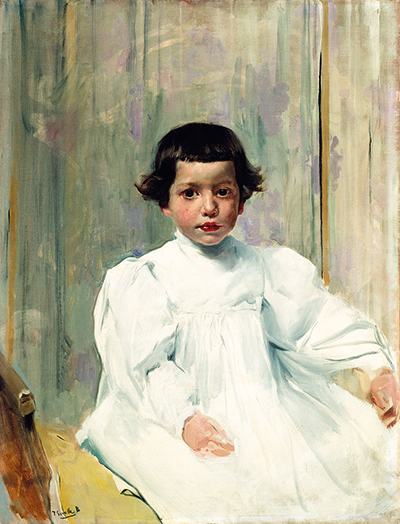This portrait is of Joaquin's son of the same name and was completed in 1896. The original name of the painting was Joaquín Sorolla García vestido de blanco, which translates into English as Joaquin Sorolla Garcia in a White Dress.
The artist loved to produce portraits of his family members, most frequently focusing on his wife and children, though occasionally reaching out further. He also painted his wife's father on occasion who was a respected photographer for much of his life. Sorolla would create all manner of different settings for these portraits, with an even mix of formal and informal environments. Some were not of the traditional portrait poses, either, where he might work outdoors and capture his children playing in a park or by the beach. In the case of this painting, though, it is very much the standard set up, with the young boy sat in position as his father works. The child is clearly aware of the situation as he looks directly at us and would have already become used to the nature of his father's work by this point. The artist would often picture his children is white clothing which worked well against his normal colour palettes but also underlined their purity and innocence, as seen through their father's eyes.
This painting is sized at 85cm tall, by 65cm wide, giving it the fairly standard ratio for a portrait. It is also fairly small for someone who would later go onto produce paintings that were several metres tall as his career and ambitions progressed over time. The work found here would have been intended to be hung in the family home and so a more sensible size of canvas was chosen. Interestingly, the subject would later donate this painting to the Sorolla Museum, where it can still be found today. He must have been immensely proud to have starred in the career of such an impressive artist, added to by the fact that it was indeed his father. Joaquin Jr would continue the trend set about by his parents of lavishing the museum's foundation with a number of items from the artist's life which would ultimately help to boost his own legacy and keep his reputation in the minds of future generations.
Although Sorolla did not generally sell his family portraits he would exhibit them and often found that these would gain a strong reception when exhibited around Europe. He would then use this to try to sell other paintings from his oeuvre, generally ones where his family was not featured. This scenario explains why today so many of the family pieces are now owned by the foundation as set up by Joaquin and his wife, rather than being dispersed widely among all manner of different private collections as is the case with much of the rest of his work. He worked mainly in oils throughout his career though was also an accomplished draughtsman who required those talents in order to plan effectly many of these intimate portraits, rather than attempting to amend elements directly on the canvas itself.




